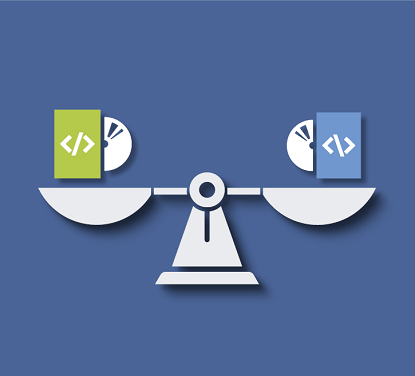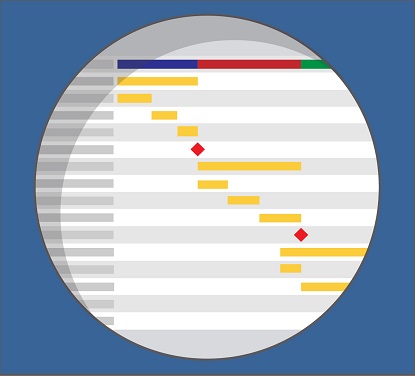03/08/2023 - Articles
Introducing software after big bang: Fast and smashing
Fast, but not without risk: In the big bang approach, the new software system is implemented at a defined point in time with full functionality. Here you can find out how the method works, where its advantages and disadvantages lie, and whether the big bang method can be used purposefully for your software introduction project.
Big bang software launch - what does it mean?
The big bang method is one of the best-known software rollout strategies. In the big bang strategy, all software modules are activated for all users on a specific date. From this point in time (milestone), the new software replaces the legacy system holistically, so that users do not have to maintain processes in the new and legacy systems in parallel. Big Bang is the fastest and most cost-effective implementation strategy for large companies, because there is no need to pay for, maintain and interface multiple applications in parallel - provided everything goes according to plan.
What should be considered when implementing software using the big bang method?
With the Big Bang implementation strategy, precise planning is very important and decisive for the success of the implementation project. If problems occur, a Big Bang implementation quickly causes high costs. In the worst case scenario, if the implementation project is aborted and fails, it is not possible to "roll back" to the legacy system and all business processes come to a standstill.
The abrupt change to a new solution can be too much for many employees - acceptance problems arise. In the worst case, the new software is not accepted and the intended goal is not achieved. Therefore, it is already of great importance to pay attention to intuitive usability when selecting the software. The introduction of complex enterprise software causes problems especially if a company has not used similar software before. If different software solutions were used before, which are now to be replaced by an ERP system, the migration of the data often causes problems.
A preparatory phase is particularly important in a software implementation using the big bang method in order to minimize the high risks of the big bang implementation strategy. The technical system administrators and key users (key users/champions) must be trained in advance by the software provider's user consultants. In addition, the new software must be subjected to extensive testing in advance, with as much real data as possible. The software provider already develops all the necessary interfaces during the preparatory phase.
Software implementation after big bang: advantages and disadvantages
 |  |
|
|
|
|
|
|
|
|
A software rollout with Big Bang only makes sense if
A software rollout with Big Bang only makes sense if
- the management is fully behind the introduction of the software and supports the process,
- the employees have a positive attitude towards the introduction,
- the goals and requirements are known,
- an experienced project manager is available.
Alternatives to the Big Bang Method
In addition to software introduction according to the big bang method, purely iterative procedures, i.e. step-by-step introduction strategies and combinations of big bang approach with iterative strategies, are also possible, which may be more suitable for introduction projects in companies in individual cases.
Purely iterative approaches include:
Project-oriented software implementation
In the first implementation step, the software is used by a motivated project team (test team) for one project. After adaptations, the software is extended to every team and every project company-wide. You can find out more about the project-oriented approach, advantages, disadvantages and tips in the article "Project-oriented software implementation: customization according to experience".
Functional iterative software implementation
The modules of a modular software solution are introduced one after the other. You can find out more about introducing software using the functional iterative approach, advantages and disadvantages as well as tips on how to proceed in the article „Functional iterative software implementation: module by module to success".
Regional or departmental iterative software implementation
The software is implemented step by step across the sites or departments. You can find out more about implementing software using the regional and departmental iterative approach, advantages and disadvantages, as well as tips on how to proceed, in the article "Regional or departmental iterative software rollout".
Combined strategies are particularly suitable for very large implementation projects and offer the advantage that they can be better adapted to the individual needs and requirements of the company. This can sometimes shorten introduction times or increase acceptance of the software introduction. The risks of software introduction after Big Bang are not reduced thereby however in all cases.
Two most common combinations of iterative models with the Big Bang strategy are the following:
- Big Bang followed by functional iterative rollout: the software is introduced without preparatory agreements on the changing processes after Big Bang. The adjustments are made afterwards.
- Regional iterative introduction followed by Big Bang: First, the software is introduced step by step across the sites or departments. As soon as enough experience has been gained and the problems encountered have been solved, the software is introduced in the remaining locations according to Big Bang.
How does the big bang approach to implementation become successful?
The introduction of new business software is always a delicate matter, as such a project ties up resources and entails important consequences in terms of business processes. Choosing a strategy that is not suitable for your conditions is one of the 7 most common mistakes in implementation projects. You should avoid this at all costs in order to successfully plan and complete your software rollout.
If you are considering a big-bang enterprise software rollout, there are numerous ways to improve your chances of success. The important thing is to consider the 11 factors that influence the choice of the appropriate strategy and take appropriate actions to optimize these factors. In this way, you can significantly increase your chances of a successful launch of the software.
If you are unsure whether a software implementation according to the Big Bang model is the appropriate approach for your implementation project, you can count on our expertise. With decades of experience in the introduction of complex software solutions, we can support your project team individually and competently through strategy finding, training, workshops and consulting.
Use Case: Introduction of Projektron BCS at items GmbH & Co. KG
In 2009, items GmbH & Co. KG, a leading IT service provider in the energy industry, was faced with the challenge of replacing its outdated project management and billing system in 2009. The existing system, an in-house development based on Access, was error-prone, not audit-proof and no longer met the company's growing requirements for (multi-)project management, project controlling and billing of services.
After a thorough market research, items opted for Projektron BCS. Decisive criteria were the comprehensive range of functions, the adaptability of the software, release stability, scalability and data protection compliance. Projektron also offered role-based training and a free test installation to check the feasibility of the requirements.
Due to the foreseeable problems with a gradual changeover during ongoing processes, items opted for a "big bang" approach. This meant that all employees used the expense recording system in Projektron BCS as soon as it was introduced and all projects, invoices and vacation requests were now only processed via the new system.
Although there were expected difficulties in the start-up phase, such as technical adjustments and retraining of individual user groups, the decision to take the "big bang" approach ultimately proved successful. Projektron BCS met items' requirements in terms of functionality, customizability, stability and data protection. The rapid changeover enabled items to work more efficiently and was well equipped for future growth.
Find out more about the introduction of BCS and the diverse use of Projektron BCS by a full-service IT provider in the user report from items GmbH und Co. KG.

"After several months of system setup, employee preparation and finally a data transfer from the old system, we started using BCS in mid-2011. We decided on a "big bang" because of the problems we could foresee with a gradual changeover to the new system within ongoing processes: we switched the expense recording for all employees to BCS immediately from the start, and all projects, payroll accounting and vacation requests/approvals were only run in the new system from this point on."
Elisabeth Königshofen
Project Management Office, items GmbH & Co. KG, Münster
Conclusion: Software implementation after Big Bang
The big bang method is a fast and cost-effective way to introduce a new software system by activating all software modules at a defined point in time. However, the introduction requires thorough planning to minimize risks such as problems with acceptance, higher costs and interruptions to business processes. Intuitive usability of the new software, training of key users and tests with real data are important prerequisites for the success of a Big Bang introduction.
The advantages of the Big Bang approach include rapid implementation, manageable costs and avoidance of compatibility issues, while potential disadvantages include higher risks, greater impact on business operations and less flexibility. The decision as to whether the Big Bang method is suitable for a software implementation project depends on the complexity of the software, the size of the company and, above all, the experience of the project manager and the project team.

About the author
Francisco Josué Artaza has been working with Projektron GmbH for 15 years, currently as marketing manager and user consultant. He is certified according to IPMA, PRINCE2 as well as Scrum Product Owner. He is an expert in software implementation strategies and has developed a tool that facilitates the selection of the appropriate strategy.
More interesting articles in the Projektron blog

Project management software comparison 2024
Get an up-to-date overview: We compare 13 of the most popular and best project management software solutions. Start here, discover the market and compare for yourself!

7 advantages of PM software
From better Excel spreadsheets to comprehensive business coordination software: what advantages does project management software offer and for whom is it worth buying a PM tool? We provide 7 good reasons why your company will benefit from project management software.

Choosing PM software
If your SME or company is about to choose project management software, you probably don't know where to start looking for the right PM tool for you. This guide will guide you through the PM software market and lead you to the right decision in 9 steps.

Project communication
One of the main reasons for project failure is a lack of project communication - according to a PMI study, communication management in a project is just as important as an accurate cost estimate, a clear definition of project goals and a thorough risk analysis. 3 practical tips for your project communication!

big bang rollout strategy, big bang approach, big bang method, big bang strategy, software implementation after big bang, software implementation big bang, big bang approach, fproject software implementation, software implementation strategies, software implementation strategies, software implementation, software implementation strategies, big bang software implementation, software implementation methods, software roll out, software rollout, software implementation, software successful implementation, software implementation planning, software implementation structured, agile software implementation, software implementation opportunities, software implementation forms, software implementation forms, software implementation risks















